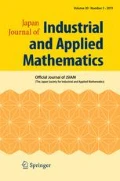Abstract
For analysis of electromagnetic fields, differential forms are useful mathematical tools. Discrete exterior calculus (DEC) is a finite-difference-type framework of discretization of the discrete differential forms. Although several numerical estimations of errors of DEC have been reported, a tangible theoretical error bound is not established. One reason of this is that there are two norms that have been commonly used for the discrete differential forms. In this paper, we show that on any quasi-uniform mesh, the two norms of the discrete differential forms in DEC are equivalent, and moreover, the order of accuracy of the discrete differential forms are independent of the choice of the norm. As an application, it is shown that the accuracy of the discrete Hodge operator of DEC is of the second-order if any quasi-uniform Delaunay mesh is adopted.










Similar content being viewed by others
References
Arnold, D.N., Falk, R.S., Winther, R.: Finite element exterior calculus, homological techniques, and applications. Acta Numerica 15, 1–155 (2006)
Bell, N., Hirani, A.N.: PyDEC: Software and algorithms for discretization of exterior calculus. ACM Trans. Math. Softw. 39(1), 1–43 (2012)
Bochev, P.B., Hyman, J.M.: Principles of mimetic discretizations of differential operators. In: Arnold, D.N., Bochev, P.B., Lehoucq, R.B., Nicolaides, R.A., Shashkov, M. (eds.) Compatible Spatial Discretizations, pp. 89–119. Springer, New York (2006)
Bossavit, A.: Whitney forms: a class of finite elements for three-dimensional computations in electromagnetism. IEE Proc. A Phys. Sci. Measure. Instrum. Manage. Educ. Rev. 135(8), 493–500 (1988)
Bossavit, A.: Computational Electromagnetism. Academic Press, Boston (1998)
Brenner, S., Scott, R.: The Mathematical Theory of Finite Element Methods, 3rd edn. Springer-Verlag, New York (2008)
Cheng, S.W., Dey, T.K., Shewchuk, J.R.: Delaunay Mesh Generation. CRC Press, Boca Raton (2013)
Desbrun, M., Hirani, A.N., Leok, M., Marsden, J.E.: Discrete Exterior Calculus. Arxiv preprint arXiv:math0508341 (2005)
Dodziuk, J.: Finite-difference approach to the Hodge theory of harmonic forms. Am. J. Math. 98(1), 79–104 (1976)
Eisenberg, M.A., Malvern, L.E.: On finite element integration in natural co-ordinates. Int. J. Numer. Methods Eng. 7(4), 574–575 (1973)
Gross, P.W., Kotiuga, P.R.: Data structures for geometric and topological aspects of finite element algorithms. Progr. Electromagn. Res. 32, 151–169 (2001)
Hiptmair, R.: Discrete Hodge operators. Numerische Mathematik 90(2), 265–289 (2001)
Hiptmair, R.: Finite elements in computational electromagnetism. Acta Numerica 11, 237–339 (2002)
Hirani, A.: Discrete Exterior Calculus. Ph.D. thesis, California Institute of Technology (2003)
Hirani, A.N., Kalyanaraman, K., Vanderzee, E.B.: Delaunay Hodge star. CAD Comput. Aided Design 45(2), 540–544 (2013)
Hirani, A.N., Nakshatrala, K.B., Chaudhry, J.H.: Numerical method for darcy flow derived using discrete exterior calculus. Int. J. Comput. Methods Eng. Sci. Mech. 16(3), 151–169 (2015)
Kobayashi, K.: A recursive formula for the circumradius of the n-simplex. Forum Geometricorum 16, 179–184 (2016)
Mohamed, M.S., Hirani, A.N., Samtaney, R.: Comparison of discrete Hodge star operators for surfaces. CAD Comput. Aided Design 78, 118–125 (2016)
Munkres, J.R.: Elements of Algebraic Topology. Addison-Wesley Publishing Company, Menlo Park (1984)
Nicolaides, R., Trapp, K.: Covolume discretization of differential forms. In: Arnold, D.N., Bochev, P.B., Lehoucq, R.B., Nicolaides, R.A., Shashkov, M. (eds.) Compatible Spatial Discretizations, pp. 161–171. Springer, New York (2006)
Rylander, T., Bondeson, A., Ingelström, P.: Computational Electromagnetics. Springer Science & Business Media, New York (2005)
Waldron, S.: The error in linear interpolation at the vertices of a simplex. SIAM J. Numer. Anal. 35(3), 1191–1200 (1997)
Whitney, H.: Geometric Integration Theory. Princeton University Press, Princeton (1957)
Acknowledgements
This work was supported by PRESTO, JST (JPMJPR16EC) and JSPS KAKENHI Grant Number JP26400200.
Author information
Authors and Affiliations
Corresponding author
About this article
Cite this article
Satoh, T., Yaguchi, T. On the equivalence of the norms of the discrete diffrential forms in discrete exterior calculus. Japan J. Indust. Appl. Math. 36, 3–24 (2019). https://doi.org/10.1007/s13160-018-0334-8
Received:
Revised:
Published:
Issue Date:
DOI: https://doi.org/10.1007/s13160-018-0334-8



